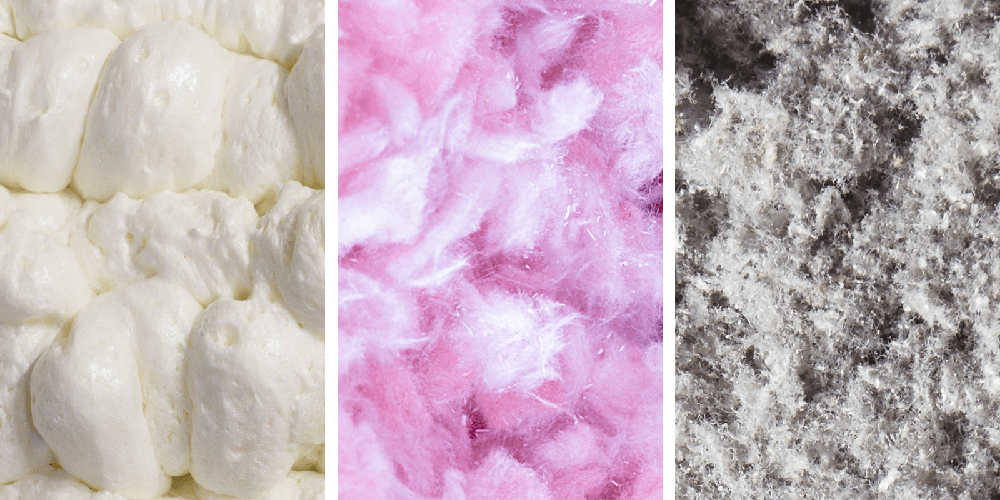Insulation Overview: Foam, Fiberglass & Cellulose
Insulation in Arizona homes falls under three product categories: foam, fiberglass & cellulose. The following article is a general overview of each product and its characteristics.
INSULATION FOAM

Foam Insulation
Excellent heat resistance and complete air seal. Also, foam protects your ducts from the desert heat.
Insulation foam and foam insulation are the same product. The manufacturing industry uses the former term. Whereas, the building industry uses the latter.
Typically, you spray apply foam products. However, in some situations you can inject it into your wall cavities.
Foam Positives
The primary benefit of foam is that it is two complimentary products in one. Foam is insulation and its a sealed air barrier.
In an attic, spray foam insulators apply foam to the bottom side of your roof. Consequently, the foam protects the cool air in your ducts from the desert heat. In a spray foam sealed attic the insulation protects the living space and the HVAC system.
Finally, spray foam insulation lasts for generations. After you foam your attic and walls, you’ll never have to insulate again.
Foam Negatives
Foam costs more than other insulation products. Also, it requires an experienced technician to achieve a proper installation and air seal. In attics, incorrectly applied foam insulation is more challenging to fix than poorly installed fiberglass or cellulose.
FIBERGLASS

Fiberglass Insulation
Moderate heat resistance, but no air seal. Fiberglass is always pink or white in color.
Fiberglass Positives
Fiberglass insulation is cheap and easy to install in your house. In the past, contact with fiberglass would irritate your skin and cause you to itch for many days. But, nowadays, fiberglass does not itch.
You can easily install single-piece fiberglass batts in your walls. However, in your attic, blown-in loose fiberglass is a better solution. Blown-in fiberglass has an advantage over fiberglass batts because it protects the bottom of the roof truss from the heat.
Additionally, fiberglass takes much longer to break down than cellulose. When correctly installed, your fiberglass insulation will insulate well for many years longer than cellulose.
Fiberglass Insulation Negatives
You must install fiberglass over an airtight surface for the fiberglass to insulate correctly. However, it is rare to find insulation installed over a sealed surface in existing homes in Arizona.
Fiberglass insulation must be installed over an airtight surface to insulate correctly.
But, even if you correctly install fiberglass in your attic, it still does not protect the cool air in the ducts from the desert heat.
A Bit About Air Sealing
Air sealing became an integral component of the building code in Arizona in the early 90s. Most Valley cites adopted 1991 International Energy Conservation Code (IECC) revisions by 1995. The 1991 IECC revisions were the first code rules to cover air sealing the exterior envelope of a home.
However, Arizona cities, including Phoenix and the entire Valley, never enforced the air sealing portion of the code. Without an airtight seal, heat flows right through your insulation in the form of air leaks. Consequently, older homes in the Valley have poorly performing insulation in their walls and attics.
Furthermore, after adopting the 2012 IECC revisions with its stringent air sealing and testing requirements, many cities still do not enforce the air sealing portion of the code. Fortunately, in the last few years, this practice has slowly started to change.
CELLULOSE

Cellulose Insulation
Low heat resistance and no air seal. Insulates well in the beginning, but degrades quickly.
Cellulose Insulation Positives
Cellulose is the cheapest way to insulate your attic. Because of this fact, it is the most common insulation product found in Phoenix attics.
Secondly, when you mix cellulose with an adhesive and spray it into wall cavities, it does not degrade over time. Furthermore, the adhesive & cellulose combination insulates your walls more efficiently than fiberglass batts. Cellulose mixed with adhesive is commonly called “wet” cellulose.
Finally, If you densely pack cellulose into wall cavities, it is an excellent soundproofing material. Densely packed cellulose reduces sound transmission much better than spray foam or fiberglass.
However, it is impossible to densely pack cellulose in an existing wall without damaging the drywall. So, in retrofit situations, injected foam is a better soundproofing option.
Cellulose Negatives
If you have cellulose insulation in your attic, you likely have large quantities of fine gray dust in the attic. This dust is the result of cellulose breaking apart over time. Moreover, if the cellulose is not installed over a sealed surface, the dust can be a significant contributor to household dust.
Additionally, as your cellulose degrades, it loses its ability to insulate. Consequently, you’ll need to replace your cellulose insulation more often than other insulation products.
Like fiberglass, you must install cellulose over a sealed airtight surface so it can insulate correctly. Unfortunately, since most attics in the Valley do not have an airtight ceiling/floor, you likely have underperforming cellulose insulation.
Finally, like fiberglass, even if you install cellulose correctly it still does not protect the HVAC ducts from the heat.
FINAL THOUGHTS
The best insulation for each situation varies by the type of project, your budget, and your energy efficiency goals. But, most importantly, the best insulation is correctly installed insulation. So, whatever insulation you decide to use for your project, make sure you install it according to the building code and manufacturer’s specifications.
